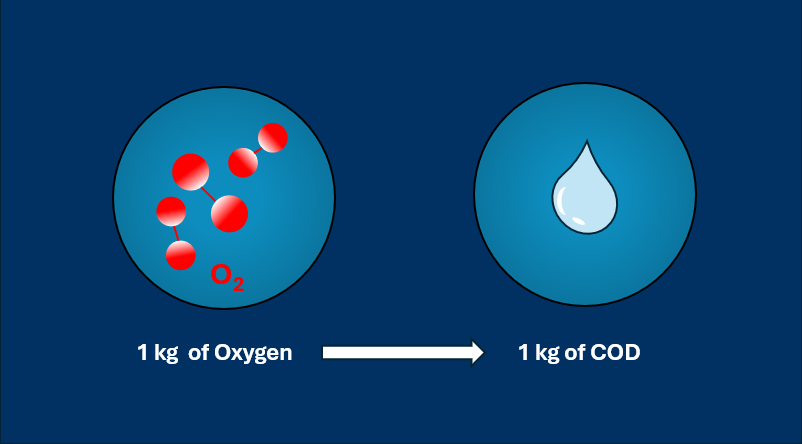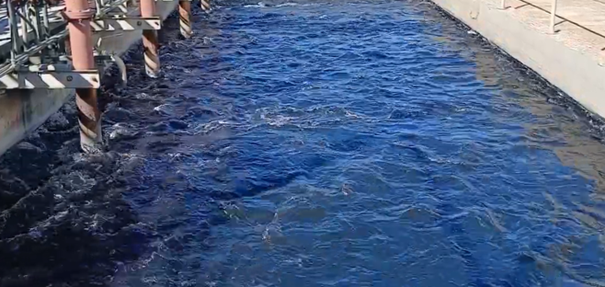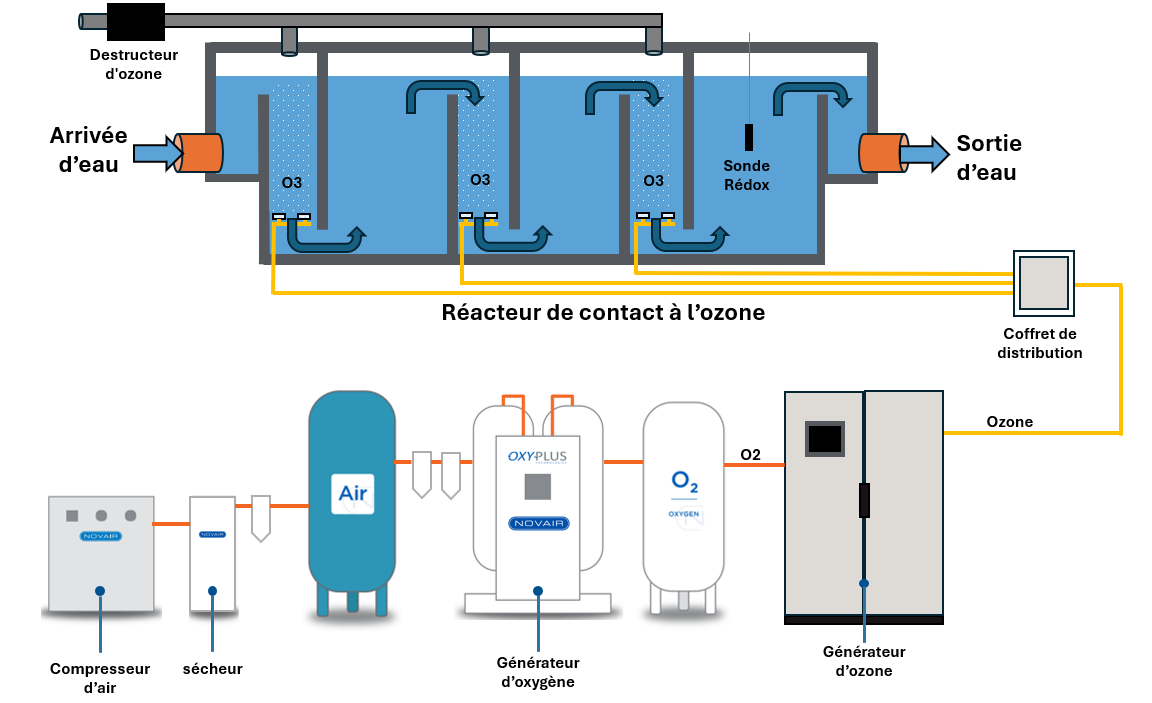
What are BOD and COD?
In the field of wastewater treatment, two parameters are essential for assessing organic pollution: biochemical oxygen demand (BOD) and chemical oxygen demand (COD).
BOD (biochemical oxygen demand)
BOD measures the amount of oxygen consumed by micro-organisms to break down biodegradable organic matter in water. This measurement is generally taken over 5 days at 20°C in the dark, and is known as BOD5. It reflects the biodegradable portion of carbonaceous pollution in wastewater. It is a very useful indicator for assessing the performance of biological treatments.
COD (chemical oxygen demand)
COD expresses the total quantity of oxygen required to chemically oxidise all the organic matter (whether biodegradable or not) present in the water. It takes into account both
- Easily degradable organic matter,
- More resistant pollutants, such as certain chemical or mineral compounds.
It therefore gives a more global view of the pollutant load in water.
DBO5 vs COD: what are the differences?
| Criteria | DBO5 | DCO |
| Nature of oxidation | Biological (by bacteria) | Chemical |
| What is measured | Biodegradable matter | Total organic matter |
| Measurement time | 5 days at 20°c | Results in a few hours |
| Indicator of | Easily biologically treatable pollution | Overall pollution (including non-biodegradable) |
COD is always higher than BOD5. The difference between the two represents the proportion of non-biodegradable organic matter.
For domestic wastewater, the COD/BOD5 ratio is generally between 1.5 and 2, indicating good biodegradability. A ratio greater than 2.5 or 3 may indicate the presence of substances that are more complex to eliminate.

Why measure BOD and COD?
Decomposing organic matter consumes dissolved oxygen in water. In excessive quantities, they can:
- Asphyxiate aquatic fauna,
- Encourage the proliferation of algae,
- Damage the quality of natural environments.
Measuring BOD and COD enables:
- Assess the pollution load of an effluent,
- Sizing the necessary treatment,
- Check that industrial or domestic effluent complies with regulations,
- Prevent environmental impacts.
These parameters are generally essential for obtaining discharge authorisations with thresholds that must not be exceeded.
Sources of BOD and COD
Wastewater can contain a wide variety of organic matter from a wide range of sources:
- Domestic wastewater (toilets, showers, cooking);
- Industrial wastewater, particulary in:
- Food processing,
- Chemicals (pesticides, fertilizers),
- Industrial cleaning,
- Landfills (leachate water),
- Textiles or cosmetics;
- Natural sources, such as decomposing leaves or dead animals in aquatic environments.
Technologies for eliminating BOD and COD
Physical and physico-chemical treatments
- Filtration (sand, activated carbon),
- Dissolved air flotation (DAF),
- Decantation and sedimentation,
- Coagulation-flocculation.
These technologies enable the particles responsible for BOD/COD to be separated mechanically or physically, and are often used for pre-treatment or finishing.
Biological treatments

Biological treatment is a key stage in wastewater treatment, particularly for the elimination of biodegradable pollution, measured by BOD₅. These processes rely on the action of micro-organisms capable of degrading organic matter, using two main approaches:
- Anaerobic treatment: in the absence of oxygen, certain specialized bacteria degrade organic matter in closed systems such as digesters or UASB (Upflow Anaerobic Sludge Blanket) reactors. In particular, this process enables the production of biogas (a mixture of methane and CO₂), which can be recovered for energy.
- Aerobic treatment: in the presence of oxygen, micro-organisms consume organic pollution to grow and multiply. This route is the most widely used in wastewater treatment plants, through processes such as activated sludge or stirred bed bioreactors (MBR)The supply of oxygen is traditionally provided by aeration (super-pressurized air introduction), but the use of oxygen-enriched gas or pure oxygen is seeing increasing development, particularly in plants constrained by high performance or load variability.
Pure oxygen: a lever for optimizing aerobic treatment
Direct injection of pure oxygen into biological basins helps to boost the efficiency of BOD₅ treatment, by stimulating micro-organism respiration.
Compared to air (which contains only 21% oxygen), pure oxygen offers major operational advantages:
- A higher transfer efficiency (up to 95%),
- A increase in treatment capacity (up to +50%) without heavy modification of existing facilities.
Furthermore, pure oxygen ensures better responsiveness to peaks in organic or hydraulic load, while greatly limiting:
- The formation of foam in aerated basins (often caused by filamentous bacteria),
- The emissions of VOCs (volatile organic compounds) and aerosols,
- The use of chemical defoamers
As a complement, some processes incorporate partial ozonation of biological sludge, contributing to:
- Reduce filamentous bacterial proliferation,
- Improve settling (and therefore clarification),
- Limit the production of excess sludge
These systems are generally designed for rapid integration, with high-performance injectors combining oxygen transfer and mixing, and automated regulation via dissolved oxygen or redox potential probes, guaranteeing real-time adaptation to process needs.
H2 Oxidation of COD by ozone

Ozone, an unstable gas made up of three oxygen atoms, has a very high oxidation potential. It is capable of breaking down many complex and resistant molecules, particularly those that are not attacked by micro-organisms in conventional biological treatment. It can therefore :
- Mineralize certain pollutants directly (complete oxidation),
- Transform refractory compounds into more readily biodegradable intermediate molecules, thus preparing for complementary biological treatment
It can be applied at two key moments:
- In pre-treatment, the aim is to reduce toxicity and increase biodegradability of effluents, by facilitating the work of bacteria in biological reactors.
- In tertiary treatment, ozone comes into play after the biological stages, to eliminate residual pollutants, including many emerging micropollutants (drug residues, endocrine disruptors, etc.).
I vantaggi dell'ozonizzazione sono numerosi:
- Eliminazione efficace dei composti non biodegradabili,
- Riduzione dei microinquinanti e disintossicazione dell'acqua,
- Disinfezione senza produzione di sottoprodotti nocivi,
- Decolorazione degli effluenti, in particolare nell'industria tessile e alimentare,
- Miglioramento della decantazione dei fanghi con un indice di volume ridotto,
- Riduzione significativa della produzione di fanghi biologici (fino al 50%), limitando i costi di trattamento e trasporto.
Finally, ozone has an important logistical advantage: it is produced on site, from pure oxygen via an ozone generator, which avoids the management, storage or transportation of hazardous chemicals, unlike other oxidants such as chlorine.
BOD/COD monitoring and reduction: WWTPs and industrial effluents
Monitoring BOD₅ (5-day Biochemical Oxygen Demand) and COD (Chemical Oxygen Demand) is essential for controlling the quality of aqueous discharges, whether urban or industrial wastewater. These two indicators make it possible to assess the organic load and the presence of oxidizable compounds in an effluent, guiding appropriate treatment choices.
In wastewater treatment plants (WWTPs)

In a wastewater treatment plant, BOD and COD are monitored at several key stages:
- On entry: to characterise the raw effluent and adapt the treatment processes.
- Between each treatment stage: to monitor intermediate performance (screening, settling, biological treatment, etc.).
- Before discharge into the natural environment: to check compliance with current standards.
The aim is to reduce organic pollution to regulatory thresholds, often set at:
- < 25 mg/l BOD₅,
- < 125 mg/l COD,
according to the European directive on urban waste water. These values are indicative only and vary from country to country, depending on local conditions and the sensitivity of the receiving environment.
Continuous improvement in purification efficiency involves advanced technologies such as pure oxygenation for biological treatment, ozonation for tertiary treatment, membrane filtration and optimised sludge treatment.
In industrial effluent treatment
Industries generate a wide variety of effluents depending on their activities (food processing, chemicals, pharmaceuticals, textiles, etc.), often loaded with pollutants that are difficult to biodegrade. Controlling BOD and COD is therefore strategic, both for:
- Meet regulatory obligations,
- Preserve water resources,
- Reduce the additional costs of sending wastewater to external treatment plants,
- Envisage the reuse of treated water (cleaning, process, irrigation...),
- Limit overall environmental impact
In this context, manufacturers are increasingly adopting advanced treatment solutions such as intensive biological treatments, chemical oxidation (notably with ozone or peroxide), or hybrid combinations (chemical pre-treatment + biological treatment).
This approach is part of a sustainable development rationale, valuing environmental performance, cost reduction and anticipation of future standards at the same time.
Conclusion: BOD and COD, pillars of water purification
Understanding and monitoring BOD and COD is essential for any entity involved in wastewater treatment, be they municipalities, industrialists or network managers.
By combining biological, physico-chemical and mechanical treatments, it is possible to achieve depollution objectives, while contributing to environmental protection and regulatory compliance

